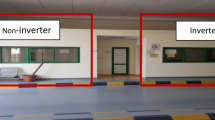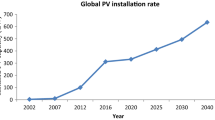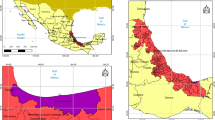Abstract
It is of great importance to improve the energy performance of the air-conditioning system for building energy conversation. Entransy provides a novel perspective to investigate the losses existing in the air-conditioning system. The progress of entransy analysis in the air-conditioning system is comprehensively investigated in the present study. Firstly missions and characteristics of the air-conditioning system are analyzed with emphasis on heat or mass transfer process. It is found that reducing the temperature difference, i.e. reducing the entransy dissipation helps to improve the performance. Entransy dissipations and thermal resistances of typical transfer processes in the air-conditioning system are presented. Characteristics of sensible heat transfer process and coupled heat and mass transfer processes are researched in terms of entransy dissipation analysis. Reasons leading to entransy dissipation are also clarified with the help of unmatched coefficient ξ. Principles for reducing the entransy dissipation and constructing a high temperature cooling system are summarized on basis of case studies in typical handling processes. It’s recommended that reducing mixing process, improving match properties are main approaches to reduce the entransy dissipation. The present analysis is beneficial to cast light on the essence of the air-conditioning system and propose novel approaches for performance optimization.
Similar content being viewed by others
References
Building Energy Research Center of Tsinghua University. 2015 Annual Report on China Building Energy Efficiency. Beijing: China Architecture & Building Press, 2015. 2–10
Pérez-Lombard L, Ortiz J, Pout C. A review on buildings energy consumption information. Energ Buildings, 2008, 40: 394–398
Chua K J, Chou S K, Yang W M, et al. Achieving better energy- efficient air conditioning–A review of technologies and strategies. Appl Energ, 2013, 104: 87–104
Yu F W, Chan K T. Improved energy performance of air cooled centrifugal chillers with variable chilled water flow. Energ Convers Manage, 2008, 49: 1595–1611
Saidur R, Hasanuzzaman M, Mahlia T M I, et al. Chillers energy consumption, energy savings and emission analysis in an institutional buildings. Energy, 2011, 36: 5233–5238
Perez-Lombard L, Ortiz J, Maestre I R. The map of energy flow in HVAC systems. Appl Energ, 2011, 88: 5020–5031
Xiao F, Wang S W. Progress and methodologies of lifecycle commissioning of HVAC systems to enhance building sustainability. Renew Sust Energ Rev, 2009, 13: 1144–1149
Yadav Y K. Vapour-compression and liquid-desiccant hybrid solar space conditioning system for energy conservation. Renew Energ, 1995, 6: 719–723
Kusiak A, Xu G L, Tang F. Optimization of an HVAC system with a strength multi-objective particle-swarm algorithm. Energy, 2011, 36: 5935–5943
Wang B X. Engineering Thermodynamics. Beijing: Higher Education Press, 2011. 65–69
Shukuya M. Exergy concept and its application to the built environment. Build Environ, 2009, 44: 1545–1550
Hurdogan E, Buyukalaca O, Hepbasli A. Exergetic modeling and experimental performance assessment of a novel desiccant cooling system. Energ Buildings, 2011, 43: 1489–1498
Jain N, Alleyne A. Exergy-based optimal control of a vapor compression system. Energ Convers Manage, 2015, 92: 353—365
Gong S Y, Boulama K G. Advanced exergy analysis of an absorption cooling machine: Effects of the difference between the condensation and absorption temperatures. Int J Refrig, 2015, 59: 224–234
Yucer C T, Hepbasli A. Thermodynamic analysis of a building using exergy analysis method. Energ Buildings, 2011, 43: 536–542
Wei Z T, Zmeureanu R. Exergy analysis of variable air volume systems for an office building. Energ Convers Manage, 2009, 50: 387–392
Manjunath K, Kaushik S C. Second law thermodynamic study of heat exchangers: A review. Renew Sust Energ Rev, 2014, 40: 348–374
IEA-EBC Annex 37. Guidebook to IEA ECBCS Annex 37-Low Exergy Systems for Heating and Cooling of Buildings. Finland: VTT Technical Research Centre of Finland, 2004. 8–12
Schmidt D. Low exergy systems for high-performance buildings and communities. Energ Buildings, 2009, 331–336
Fan B, Jin X Q, Fang X, et al. The method of evaluating operation performance of HVAC system based on exergy analysis. Energ Buildings, 2014, 77: 332–342
Sakulpipatsin P, Itard L C M, Van der Kooi H J. An exergy application for analysis of buildings and HVAC systems. Energ Buildings, 2009, 41: 90–99
Li R L, Ooka R, Shukuya M. Theoretical analysis on ground source heat pump and air source heat pump systems by the concepts of cool and warm exergy. Energ Buildings, 2014, 75: 447–455
Guo Z Y, Zhu H Y, Liang X G. Entransy—A physical quantity describing heat transfer ability. Int J Heat Mass Tran, 2007, 50: 2545–2556
Xia S J, Chen L G, Sun F R. Optimal paths for minimizing entransy dissipation during heat transfer processes with generalized radiative heat transfer law. Appl Math Model, 2010, 34: 2242–2255
Chen Q, Ren J X. Generalized thermal resistance for convective heat transfer and its relation to entransy dissipation. Chin Sci Bull, 2008, 53: 3753–3761
Xia S J, Chen L G, Sun F R. Optimal paths for minimizing entransy dissipation during heat transfer processes with generalized radiative heat transfer law. Appl Math Model, 2010, 34: 2242–2255
Cheng X T, Liang X G. Entransy flux of thermal radiation and its application to enclosures with opaque surfaces. Int J Heat Mass Tran, 2011, 54: 269–278
Chen Q, Liang X G, Guo Z Y. Entransy theory for the optimization of heat transfer-A review and update. Int J Heat Mass Transfer, 2013, 63: 65–81
Sun J, Yuan K, Yang L J, et al. Distribution optimization of circulating water in air-cooled heat exchangers for a typical indirect dry cooling system on the basis of entransy dissipation. Sci China Tech Sci, 2015, 58: 617–629
Wang W H, Cheng X T, Liang X G. Entransy dissipation, entransy- dissipation-based thermal resistance and optimization of one-stream hybrid thermal network. Sci China Tech Sci, 2013, 56: 529–536
Wang W H, Cheng X T, Liang X G. T-Q diagram analyses and entransy optimization of the organic flash cycle (OFC). Sci China Tech Sci, 2015, 58: 630–637
Cheng X T, Liang X G. T-q diagram of heat transfer and heat-work conversion. Int Commun Heat Mass Transfer, 2014, 53: 9–13
Yang W W, Cao X Q, Zhou F, et al. Performance analysis of waste heat recovery methods by T-Q diagram. J Eng Thermophys, 2015, 36: 2107–2110
Qian X D, Li Z, Li Z X. Entransy and exergy analyses of airflow organization in data centers. Int J Heat Mass Tran, 2015, 81: 252–259
Cheng X T, Liang X G. Analyses and optimizations of thermodynamic performance of an air conditioning system for room heating. Energy Buildings, 2013, 67: 387–391
Cheng X T, Liang X G. Entransy and entropy analyses of heat pump systems. Chin Sci Bull, 2013, 58: 4696–4702
Zhang L, Liu X H, Jiang Y. Application of entransy in the analysis of HVAC systems in buildings. Energy, 2013, 53: 332–342
Çarpinlioğlu M Ö. A comment on the concept of entransy (versus exergy) for the performance assessment of a desiccant cooling system. Energ Buildings, 2015, 101: 163–167
Zhang T, Liu X H, Zhang L, et al. Match properties of heat transfer and coupled heat and mass transfer processes in air-conditioning system. Energ Convers Manage, 2012, 59: 103–113
Jiang Y, Liu X H, Zhang L, et al. High temperature cooling and low temperature heating in buildings of EBC Annex 59. In: Proceedings of the 6th International Building Physics Conference, Torino, Italy, 2015
Zhang L, Liu X H, Zhao K, et al. Entransy analysis and application of a novel indoor cooling system in a large space building. Int J Heat Mass Tran, 2015, 85: 228–238
Zhang T, Liu X H, Jiang Y. Performance comparison of liquid desiccant air handling processes from the perspective of matched properties. Energ Convers Manage, 2013, 75: 51–60
Zhang L, Liu X H, Jiang Y. Application of entransy in match property of liquid desiccant dehumidification. In: Proceedings of the 15th International Heat Transfer Conference, Kyoto, Japan, 2014
Liu X H, Xie X Y, Zhang T, et al. Thermal Principle of Indoor Built Environment. Beijing: China Architecture & Building Press, 2016
Li Z, Liu X H, Zhang L, et al. Analysis on the ideal energy efficiency of dehumidification process from buildings. Energ Buildings, 2010, 42: 2014–2020
Liu X H, Jiang Y, Zhang T. Temperature and Humidity Independent Control (THIC) of Air-conditioning System. Berlin: Springer Press, 2013. 200–212
Author information
Authors and Affiliations
Corresponding author
Rights and permissions
About this article
Cite this article
Zhang, T., Liu, X., Tang, H. et al. Progress of entransy analysis on the air-conditioning system in buildings. Sci. China Technol. Sci. 59, 1463–1474 (2016). https://doi.org/10.1007/s11431-016-6087-1
Received:
Accepted:
Published:
Issue Date:
DOI: https://doi.org/10.1007/s11431-016-6087-1




